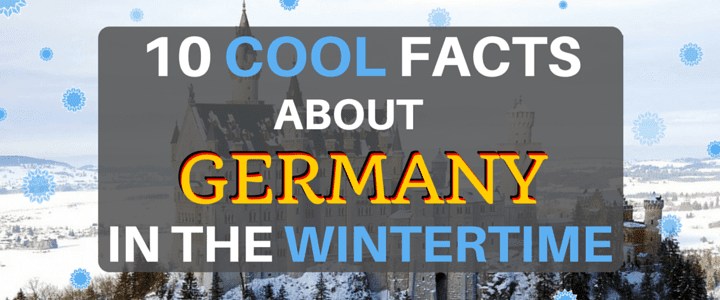 Thinking about visiting Germany in the winter? Prepare for lots of fun seasonal events and cultural nuances! In this article, overseas traveler and language teacher Carol Beth L. shares 10 cool facts about Germany that are unique to the wintertime…
Thinking about visiting Germany in the winter? Prepare for lots of fun seasonal events and cultural nuances! In this article, overseas traveler and language teacher Carol Beth L. shares 10 cool facts about Germany that are unique to the wintertime…
Perhaps you’re already familiar with what Germany has to offer; delicious beers, a rich history, and fun holidays. But did you know that Germany offers different activities and traditions in the wintertime? These are experiences that you can’t get during the summer, fall, or spring seasons. If you’re looking to travel to Germany, consider the following reasons why winter in Germany is a great time to go!
1) Greetings
In the wintertime, you’ll be greeted differently by passersby on the street. If you’re there on Christmas, the traditional Christmas greeting is “Froehiliche Weihnachten.” The traditional New Year’s Greeting is “Frohes neues Jahr.” This is the standard way to say it, but be prepared for regional variations depending on exactly where you plan to visit. For instance, “Frohes neues Jahr” might become “Gesundes neues Jahr,” or “Prosit neue Jahr.”
2) Trees
Be prepared to see a Christmas tree or two! Christmas trees were first associated with Germany. They’re said to have caught on after they proved resistance to fire when Father Boniface was preaching to the German tribes. The spruce became associated with the tree of life and with life in general in the religious plays performed for peasants in medieval times. Christmas trees were un-decorated early on; decorations are said to have begun when Martin Luther placed lit candles on his Christmas tree, representing stars in the sky.
3) Markets
Following the Christmas theme, you’ll want to visit a Christmas market! The first markets began in 1393 to provide basic supplies, but gradually became more festive in-line with seasonal celebrations. Now, most large cities and many smaller ones host a market of their own.
Look out for nativity scenes, nutcrackers, toys, ornaments, and seasonal foods such as dried plums, mulled wine, gingerbread, and bratwurst. If you’re looking for tree ornaments, look out especially for a glass pickle ornament. This is traditionally the last ornament placed on the tree late on Christmas Eve, and an extra present goes to the person who finds it.
4) Treats
Even if you don’t visit a Christmas market, keep an eye open for some of the seasonal treats mentioned above. Gingerbread houses were first invented in Germany and come up in some of their traditional stories (think Hansel & Gretel, and the later opera by Humperdinck of the same name). Local bakeries may also carry stollen, and other treats may be available in local coffee shops, restaurants, and supermarkets.
5) Calendars
In addition to the Christmas tree, Germany also pioneered the Advent calendar, with its 24 doors with a treat and some inspiring image behind each one. If you’re in or near Gengenbach during Advent, check out their town hall. It has, for some years now, effectively made itself the largest Advent calendar in the world, with its 24 windows each opening into a different room with a different scene.
6) Christmas Day
Expect Santa to come a little bit early during winter in Germany! St. Nicholas comes on December 6th in Germany, not on Christmas Day. Here’s another fun bit – he leaves candy in children’s shoes. That’s not to say there won’t still be plenty of Christmas fun to be had on December 25th!
7) Churches
If you like celebrating Christmas in a religious fashion, try attending a Christmas Eve service at Berliner Dom. If you’re not particularly religious, or if you just like classical music, try the Church of Our Lady in Munich, which has holiday music and concerts. Munich also hosts a Christmas Village in its Royal Residence in addition to the Tollwood Winter Festival.
8) Events
Though there are many traditions centered around Christmas, there’s still lots of fun to be had after Christmas. For New Year’s, look up the local public New Year’s festivities. For example, if you’re in Berlin, try showing up at Brandenberg Gate for an open air party. There are New Year’s parties going on all over the place!
9) Skiing
Germany is a wonderful place to ski! The snow is thick and lush in the mountains during wintertime. Choice locations include the German Alps and the Black Forest in south and southwest Germany. Most ski resorts are centered around southern Germany, with a few scattered through eastern and central Germany. Be sure to check around for the best prices on equipment and lodging before you settle on a place.
10) Karneval
If you’re in Germany in late winter, look for Karneval celebrations. These are a bit akin to Mardi Gras festivals. Like Mardi Gras festivals, Karneval celebrations are a chance for some fun before the season of lent begins. Zany costumes, loads of good food, and thousands of happy people are what you’ll experience at Karneval celebrations.
Now you know that there’s a LOT to do during winter in Germany. Before you pack your bags and go, be sure to look at German expressions for traveling abroad. You don’t have to know the entire language to have a good trip, so why not know the basics? If you’re looking to learn more German, however, a private German instructor is the best way to develop a deep understanding of the language. Keep up the learning and don’t be afraid to search for help!
Do any of these facts make you want to visit Germany in the wintertime? Yes or no, comment below!
 Post Author: Carol Beth L.
Post Author: Carol Beth L.Carol Beth L. teaches French lessons in San Francisco, CA. She has her Masters in French language education from the Sorbonne University in Paris and has been teaching since 2009. Learn more about Carol Beth here!
Mac











